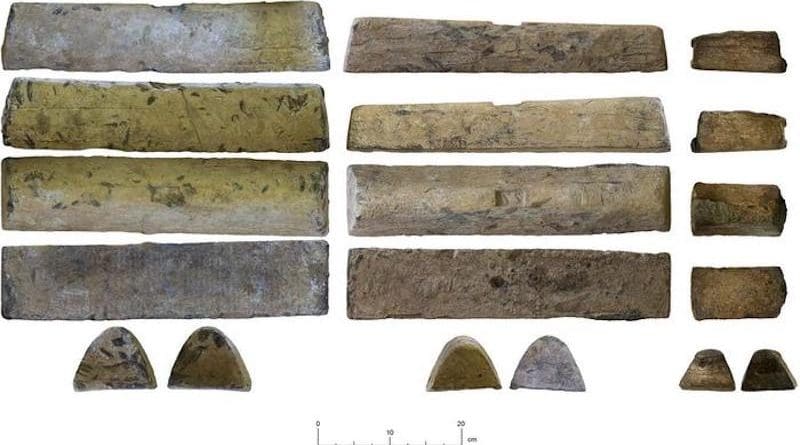Roman Lead Was Cordovan
Three ingots from the site of Los Escoriales de Doña Rama (Belmez) and dating from the Roman era demonstrate the importance of lead production and exportation in northern Cordoba.
Measuring some 45 centimeters long and weighing between 24 and 32 kilos, they are triangular in shape, resembling a Toblerone bar. There are only three of them, and one is broken in half, but the study of these three lead ingots, never studied before and from the Los Escoriales de Doña Rama (Belmez, Córdoba) deposit, yield enough information to state that ancient Cordoba, the capital of the Roman Empire’s region of Baetica, and whose territory occupied what is today the north of the province, encompassing the Guadiato Valley, Los Pedroches, and some districts of Jaen, Ciudad Real and Badajoz, was the western ancient world’s main center for the smelting of lead, a metal used to produce a multitude of everyday tools, such as spoons, tiles, pipes, etc.
The ingots, dating from the first century A.D., were unearthed in the twentieth century during work on the Maghreb-Europe gas pipeline, and were kept in the Belmez Museum and in private homes. Two of them bear an identifying mark, making it possible to reveal part of their history and to confirm the great importance of mining importance in the central Sierra Morena area during the Roman period. This mark is actually two letters, “S S”, referring to the Societas Sisaponensis, a mining company originally from La Bienvenida (Almodóvar del Campo, Ciudad Real), a land famous for the production of cinnabar, but that must have been headquartered in Cordoba.
In addition to the ingots’ triangular shape, optimizing their storage capacity, the fact that the ingots bore these letters means that they were supposed to be exported, with the mark identifying the producer of the pieces, which were then to be loaded onto ships along with other products. Thus, the mining activity in northern Cordoba was not limited to the production of lead and silver, something that was already known, but also involved exportation, placing the area among the main producers of metals intended for Mediterranean trade, a conclusion asserted by an international and multidisciplinary team led by the University of Cordoba in an article published in the Journal of Roman Archaeology.
Analysis of the ingots’ chemical composition and stable isotopes allowed the research team to verify that they were desilvered, and that the ore with which they were made was from the district of Fuente Obejuna-Azuaga, a major mining area that included the Doña Rama site where the ingots were found. In other words, the three pieces had a common origin linked to the same site where they were discovered.
The fact that the ingots were found in the same area where they were produced is exceptional, and the reason for this is unknown. Most ingots of this type have been found at the bottom of the Mediterranean Sea, at shipwreck sites, and it is precisely at the bottom of the sea where the most information has been obtained since the research team began working with specialists from the Université Toulouse who have spent years studying the composition and creating a catalogue of the ingots found there. According to the analysis, more than half of the ingots studied by the French specialists were from the district of Fuente Obejuna-Azuaga, proving Cordoba’s importance as a producer and exporter of lead ingots.
“This information demonstrates that, in antiquity, these northern regions of Cordoba boasted major metallurgical networks of great commercial and economic importance in the Mediterranean,” said UCO researcher Antonio Monterroso Checa, adding that “which reveals the level of industrialization, skill and knowledge necessary to reach that level of manufacturing.” In fact, although much remains to be studied, the Doña Rama site would seem to be a mining town complete with a foundry, a processing area and, possibly, a fortress. But, as Monterroso Checa has stated, “all this remains to be studied.”

